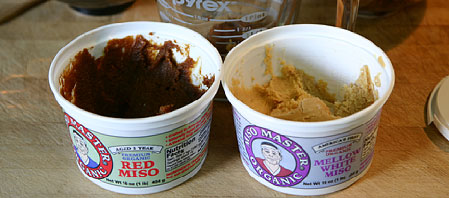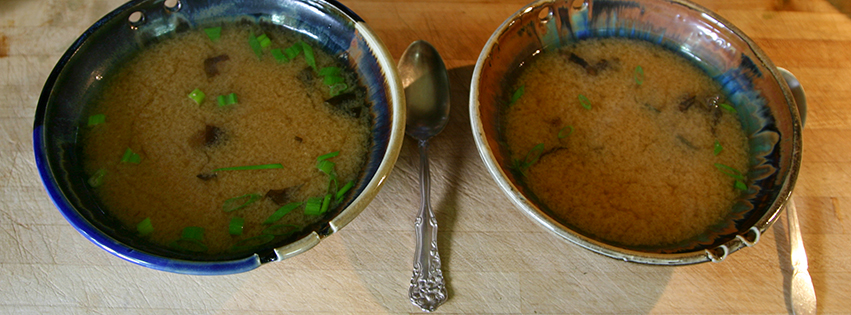 I have a good friend who, on my suggestion, tried miso. He said “I like the onion ones.”
I have a good friend who, on my suggestion, tried miso. He said “I like the onion ones.”
“???What??? are you talking about?” I asked. It turns out he missed the part about using fresh, organic miso made by Miso Master (available locally and online), and was using some instant product.
On my next visit to the store I took a look at the packaged/processed/instant offerings. As soon as I saw ingredients with long names which most would find very difficult to pronounce, as well as finding the presence of an addictive neuro-toxin (MSG), I put the package down with a sigh. That’s a “horse of a different color.”
Much of the benefit comes from the enzymes present. These enzymes are denatured (killed/ruined/made ineffective) by boiling and are “slowed” by freezing. I don’t let mine exceed 160 F. If the ONLY source was a packaged product, “flash freezing’ does the least amount of harm. Of course, ALWAYS buy organic.
If you make the soup like I do ( recipe here ) and don’t find it delicious, that would be solid proof that your mouth is truly broken. For ME and my awesome partner to find something to be still be yummy (something we look forward to) after eating the same thing (with slight variations) every day (OK, 14 out of 15 days) for over a year is proof that it’s yummy.
I’ve made miso at three pot-luck gatherings (about 75 people total) and so far the ONLY person who didn’t like it was allergic to fish. The stock (dashi) I make has fish (smoked bonito) as well as seaweed (kombu) and shiitake (shiitake – lol) mushroom elements. It really is not at all “instant” since rehydrating the shrooms takes about 30 minutes of simmering.
NOTE: (Hey, where’d my water go?) After making the shiitake dashi some of the water has left the pan and gone traveling in the form of steam. Since I make the every day, I put a mark on a chopstick or two to easily measure (like a dipstick) how much water to add back in (to bring the level back up to the mark).
I like (and get) the 16 oz Miso Master because it’s organic, it’s made in North Carolina and is as far away from Fukushima as possible, and is sitting right there on the refrigerated grocery shelf (i.e. locally available). If I had more fridge space, I’d buy a larger pail. I like the barley, the red, and the white in different combinations. Any one of them alone, or all three (I call that neopolitan), or any two together! The chickpea style is probably good for something like hummus or some sauces, yet did not “do it for me” as a soup. Here is the recipe page from the friendly and informative distributors of Miso Master…scroll down the page for the miso recipes
You’d think I have some financial interest in these companies. Nope. Your store might order it? Here is another page worth reading:
Here is the book I am totally enjoying. It’s written by the Miso Master people. Log on to Amazon via my link on this page and do a search for “The Miso Book: The Art of Cooking with Miso.” In fact, it’s OK with me if you do ALL your amazon shopping through my link! It’s a great book that shares stories, the science, and has great and healthful recipes.
They say the shelf life is about 2 years (per the “use by” dates on the packages), yet I understand it’s really more like 10 years if refrigerated. The fermentation process restarts if it’s taken back to room temperature.
Ima gonna go make us some NOW!

We have a bowl of miso soup every day (14 out of 15 days)


